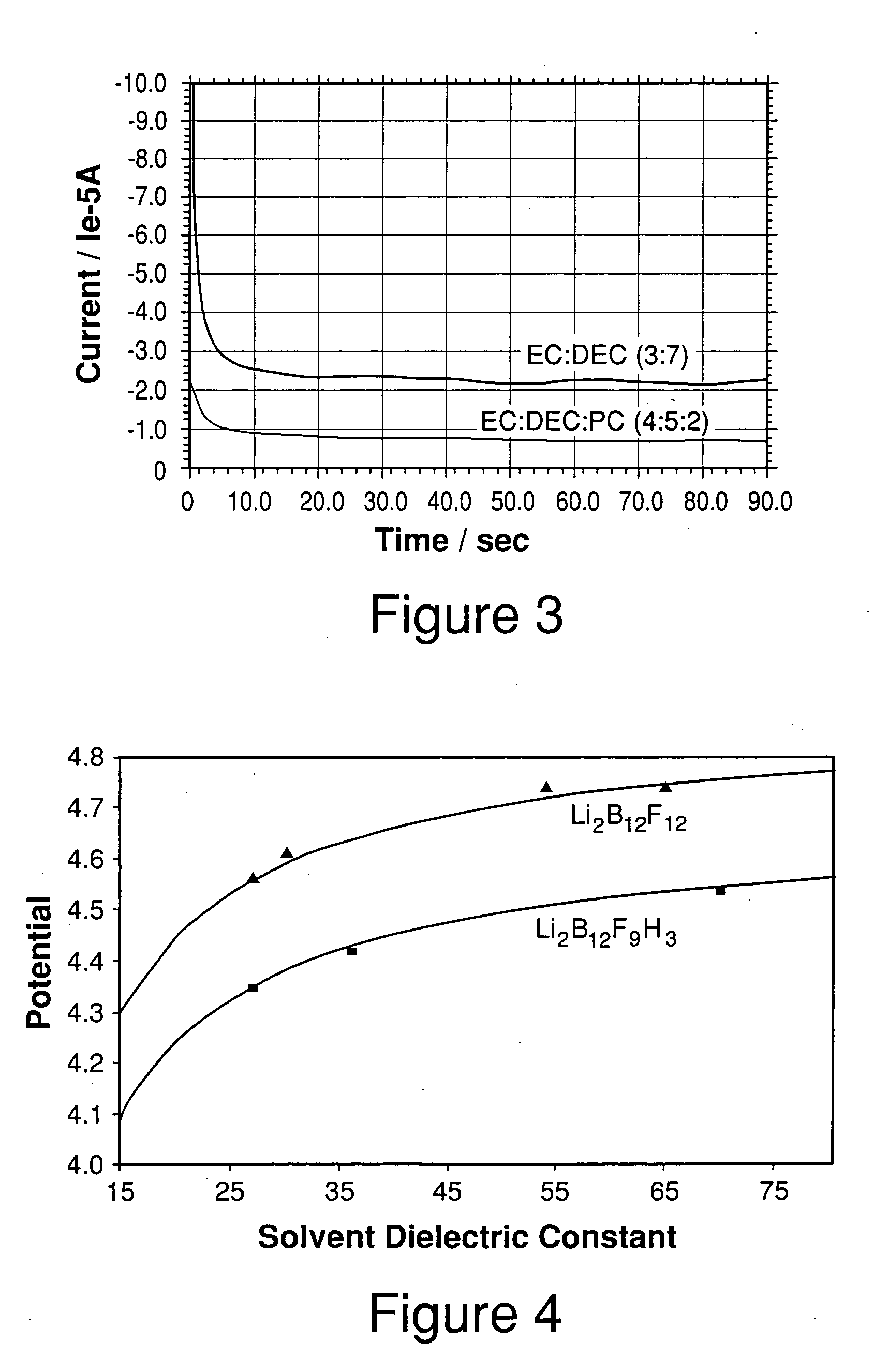Overcharge protection for electrochemical cells
- Summary
- Abstract
- Description
- Claims
- Application Information
AI Technical Summary
Benefits of technology
Problems solved by technology
Method used
Image
Examples
example 1
Preparation of Solvents with Different Dielectric Constants
[0059] 4 parts by weight of EC (dielectric constant of 89 at 25° C.), 5 parts by weight of DEC (dielectric constant of 2.8 at 25° C.) and 2 parts by weight of PC (dielectric constant of 65 at 25° C.) were mixed together to obtain a solvent mixture with a dielectric constant of approximately 40; 3 parts by weight of EC and 7 parts by weight of DEC were mixed together to obtain a solvent mixture with a dielectric constant of approximately 28. The dielectric constants of the pure solvents were obtained from literature [Kang Xu, Chemical Reviews, 2004,104, 4303-4417] and the dielectric constants of the solvent mixtures were estimated using mixing rules for solvent mixtures [Lithium Batteries (Science and Technology), Glolam-Abbas Nazri and Gianfranco Pistoia (Eds.), Chapter 17, M. Nazri, Kluwer Academic Publishers (2004)].
example 2
Oxidation / Reduction of Li2B12F9H3 in EC / DEC
[0060] Cyclic voltammetry experiments were carried out in 0.4 M Li2B12F9H3 in EC:DEC (3:7) solutions at a scan rate of 5 mV / s. Pt disk (area=0.02 cm2) was used as the working electrode and Li foils were used as counter and reference electrodes. FIG. 1 and Table 1 show the results obtained. The Li2B12FgH3 electrolyte has a threshold potential of about 4.32 V in EC:DEC (3:7). The threshold potential is defined here as the potential corresponding to an oxidation current density of 0.1 mA cm−2 observed in cyclic voltammetry experiments. The Li2B12F9H3 overcharge protection salt used in this Example was a mixture of Li2B12FxH12-x where x was predominantly 9 with lesser amounts of x=6, 7, 8,10, 11, and 12.
example 3
Oxidation / Reduction of Li2B12F12 in EC / DEC
[0061] Cyclic voltammetry experiments were carried out in 0.4 M Li2B12F12 in EC:DEC (3:7) solutions at a scan rate of 5 mV / s. Pt disk (area=0.02 cm2) was used as the working electrode and Li foils were used as counter and reference electrodes. FIG. 1 shows the result obtained. The Li2B12F12 electrolyte has a threshold potential of about 4.5 V in EC:DEC (3:7). Based upon Example 2 and 3 data, then, one might expect both Li2B12F9H3 and Li2B12F12 to be well suited as redox shuttles in a 4 volt lithium ion cell. Additionally, comparing the threshold potentials for this example and example 2 indicates that Li2B12F9H3 has a lower threshold potential than Li2B12F12; therefore, having fewer fluorines on a borate cluster should provide a lower threshold potential. The Li2B12F12 overcharge protection salt used in this Example was a mixture of Li12B12FxH12-x where x was predominantly 12 with lesser amounts of x=10 and 11.
PUM
| Property | Measurement | Unit |
|---|---|---|
| Percent by mass | aaaaa | aaaaa |
| Electric potential / voltage | aaaaa | aaaaa |
| Fraction | aaaaa | aaaaa |
Abstract
Description
Claims
Application Information
 Login to View More
Login to View More - R&D
- Intellectual Property
- Life Sciences
- Materials
- Tech Scout
- Unparalleled Data Quality
- Higher Quality Content
- 60% Fewer Hallucinations
Browse by: Latest US Patents, China's latest patents, Technical Efficacy Thesaurus, Application Domain, Technology Topic, Popular Technical Reports.
© 2025 PatSnap. All rights reserved.Legal|Privacy policy|Modern Slavery Act Transparency Statement|Sitemap|About US| Contact US: help@patsnap.com



